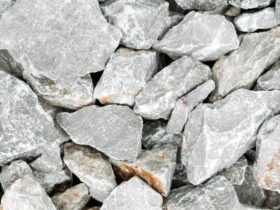Slate is a fine-grained, foliated metamorphic rock. It originates from the metamorphism of shale under low-grade conditions.
Slate is a durable and naturally occurring rock known for its ability to split into thin, smooth sheets. Commonly found in a range of earthy colors, slate has been essential in construction and architectural applications due to its strength and aesthetic appeal.
This rock is also utilized for roofing, flooring, and landscaping purposes. It forms as a result of compression and underground heat, which alter its crystalline structure, enhancing its characteristic cleavage. The transformative journey of slate from shale gives it unique properties that make it a preferred material for many traditional and contemporary designs. Its versatility, tactile surface, and timeless quality keep it in high demand for both functional and decorative uses.
Slate’s Geologic Origins
Slate starts as a tale spun by the earth itself. It forms over ages, telling stories of pressure, heat, and change. A rock born from transformation, slate holds secrets of ancient worlds in its layers.
Formation Process
Imagine a journey millions of years long. That’s the slate formation process. It begins with shale, a sedimentary rock. Shale forms from mud, rich in clay, settling in layers at the bottom of water bodies.
With time, these layers get buried under more sediment. They sink deeper into the earth’s crust. Heat from the earth’s core and pressure from overlying layers work together. They transform shale into slate.
This process is called metamorphism. During metamorphism, shale undergoes extreme pressure and heat but does not completely melt. This forms the tightly-forged layers of slate.
Minerals And Composition
The enchanting layers of slate conceal a blend of minerals. Quartz and muscovite are the main players. They are joined by biotite, chlorite, hematite, and others. These minerals give slate many of its best features.
| Mineral | Role in Slate |
|---|---|
| Quartz | Adds hardness |
| Muscovite | Gives sheen |
| Biotite | Supplies color |
| Chlorite | Offers toughness |
Each mineral in slate’s makeup plays a unique part. Together, they create a rock that’s durable and visually striking. The mineral composition also affects color and texture, giving slate its signature appearance.
Physical And Chemical Characteristics
The physical and chemical characteristics of slate make it a unique and versatile rock. Slate forms when shale, composed mostly of clay minerals, undergoes metamorphism. This change involves intense heat and pressure, altering its structure. Let’s delve into the specific features, such as color spectrum and its durability and hardness.
Color Spectrum
The color of slate can range widely. This versatility makes it suitable for various design and architectural uses. The minerals within the rock contribute to its color palette.
- Blues and grays are common, reflecting its shale origins.
- Rusts and reds occur when the rock contains iron compounds.
- Greens appear due to chlorite or other green minerals.
- Mixed colors arise from the mix of these minerals.
Durability And Hardness
Slate is known for its impressive durability. Its resistance to weathering makes it a choice material for roofing and outdoor flooring.
| Property | Characteristic |
|---|---|
| Hardness | Slate has a Mohs hardness of about 6. |
| Density | Its density enhances its strength. |
| Cleavage | Good cleavage allows it to be split into thin sheets. |
| Water Absorption | Low water absorption adds to its longevity. |
The structure of slate contributes to its strength. Its foliated texture arises from the parallel alignment of platy minerals. These features give slate its ability to endure elements over time.
From Quarry To Market
Slate, a metamorphic rock, begins its journey deep beneath the Earth’s surface. Versatile and strong, this fine-grained rock emerges into the world, ready to be shaped into timeless products. The journey from quarry to market involves meticulous processes, shaping the slate for its end use, whether for roofs, floors, or artistic expressions.
Slate Mining Techniques
The extraction of slate requires precision and care. Miners extract slate from quarries using two main techniques:
- Drilling and splitting: Workers drill holes along the natural planes of the slate. They then insert wedges to split the slate along its layers.
- Controlled explosives: In larger quarries, controlled explosives break larger slate blocks from the earth carefully without damaging the slate’s integrity.
Processing And Shaping Slate
Once mined, the process of turning raw slate into functional material begins. It involves several steps:
- Sizing: Workers cut large slate blocks into thin, workable sheets.
- Trimming: Specialists trim these sheets to specific dimensions, ensuring a uniform appearance.
- Finishing: Finally, the surface of the slate is finished according to its intended use – from natural textured to smooth polished.
Each step ensures the slate meets strict quality standards before arriving at the market.
Versatile Uses Of Slate
Slate stands out for its durability and aesthetic appeal. Various industries embrace slate due to its versatility. From timeless architecture to sleek interior designs, slate has proven to be a material of choice. Its natural beauty and longevity make it a go-to for many projects.
Architecture And Roofing
The use of slate in architecture and roofing is celebrated. This rock forms resistant and beautiful surfaces that withstand decades. Architects often recommend slate for:
- Long-lasting roofs that offer a classic look.
- Exterior cladding that resists weather extremes.
- Outdoors for pathways and patios, thanks to its natural slip resistance.
Slate roofs have a distinctive style. They also provide fire protection and are eco-friendly, made from natural materials.
Interior Design And Decor
In interior spaces, slate brings a slice of the outdoors inside. Designers love slate for its:
- Elegance in flooring, adding a luxurious touch to any room.
- Variety in color and texture, from sleek blacks to rustic greens.
- Use in kitchen countertops due to its capacity to resist stains and bacteria.
Its thermal properties also make it ideal for radiant heating systems. Not to forget, slate’s ease of cleaning and maintenance is a huge plus for busy households.
Caring For Slate Products
Slate boasts durability and aesthetic appeal.
Commonly used in flooring, roofing, and tabletops, slate requires proper care.
Learn to maintain slate’s elegance with our tips.
Maintenance Tips
Keeping slate in top condition is straightforward.
Regular cleaning and preventive measures are key.
- Use a soft mop or cloth to clean slate surfaces.
- Warm water and mild detergent work best.
- Avoid acidic cleaners as they can damage the slate.
- Quickly clean up spills to prevent staining.
- Applying sealer annually protects the surface.
Longevity And Weather Resistance
Slate is a champion of longevity. Slate features exceptional weather resistance, serving well in diverse climates.
To ensure longevity:
- Regularly inspect for cracks.
- Replace damaged tiles promptly.
- Reapply sealant as recommended.
- Avoid harsh physical impacts.
- Clear debris from slate roofing frequently.
Environmental Impact
Slate is a natural stone known for its durability and longevity. The environmental impact of slate includes various factors from its extraction to its lifetime use. Understanding these impacts helps in making eco-friendly choices.
Sustainability Considerations
Slate is a naturally occurring material with a low processing requirement. This makes its carbon footprint smaller when compared to synthetic materials. Factors linked to slate sustainability include:
- Mining practices: Responsible mining reduces environmental harm.
- Energy consumption: Slate requires less energy to process.
- Longevity: Its durability means less frequent replacement.
- Transport: Local sourcing lowers transportation emissions.
Recycling And Reuse
Slate can be recycled and repurposed for various uses. Old slate tiles become new products, reducing waste. Benefits include:
- Waste reduction: Less material in landfills.
- Energy efficiency: Less energy than making new slate.
- Resource conservation: Reuse preserves natural slate reserves.
Frequently Asked Questions On What Type Of Rock Is Slate
Is Slate A Clastic Sedimentary Rock?
Yes, slate is a clastic sedimentary rock formed from shale through low-grade metamorphism. It consists of fine-grained particles.
Is Slate A Soft Or Hard Rock?
Slate is a hard rock, known for its durability and strength. It forms through the metamorphosis of shale, a sedimentary rock.
Is Slate An An Igneous Stone?
No, slate is not an igneous stone; it’s a metamorphic rock formed from shale.
Is Slate Foliated Or Nonfoliated?
Slate is a foliated metamorphic rock, characterized by its layered appearance. This occurs due to the aligned sheet-like planar structures.
Conclusion
Slate stands out as a natural choice for various applications, thanks to its durability and elegant appearance. This fine-grained metamorphic rock embodies a blend of reliability and aesthetics. Whether for construction, art, or everyday use, slate’s versatility is unmatched. Choosing slate means investing in long-lasting quality and timeless style.









Leave a Reply